Impact of Iron Ore Pre-Reduction Degree on the Hydrogen Plasma Smelting Reduction Process
Abstract
1. Introduction
Fluidized Bed Reduction as a Comparable Alternative Technology
2. Equipment and Methods
2.1. Laboratory Equipment for Plasma Reduction
2.2. Used Materials
2.3. Experimental Plan and Procedure
2.4. Evaluation Methods
2.5. Microstructural Characterization
3. Results and Discussion
3.1. Reduction Progression
3.2. Comparison and Integration with Fluidized Bed Reduction
3.3. Microstructural Examination
- ZnO(s) + H2 → Zn(g) + H2O(g) at T = 907–1975 °C, i.e., solid domains enriched in ZnO would be reduced by hydrogen stemming from the atmosphere before the material is completely melted, and the product metallic Zn rapidly evaporates. This temperature range could plausibly exist within regions of the samples that are not in direct contact with the arc.
- ZnO(l) + H2 → Zn(g) +H2O at T = 1975–2360 °C, i.e., molten ZnO domains would be reduced by hydrogen stemming from the plasma arc and the metallic Zn evaporated rapidly. The temperature range can be found in the outer zone of the arc (i.e., where the material is in direct contact with the colder domains of the arc).
- ZnO(g) + H2 → Zn(g) + H2O at T > 2360 °C. In this scenario, fast evaporation of ZnO would occur and the reduction of the vapor oxide proceeds in the gas phase. Temperatures above 2360 °C can be expected in the focal spot of the plasma arc.
4. Conclusions and Outlook
4.1. Reduction Behavior
- Analysis of the pre-melting phase shows that moisture significantly influences electrode consumption. The heterogeneous and homogeneous water–gas shift reaction erodes the graphite in addition to the released oxygen of the thermal decomposition of the iron ore.
- Higher pre-reduction degrees and reduction rates for the hematitic ore compared to the wüstite ore were achievable due to the decomposition of Fe2O3. This was also determined for the residual materials EC and EP.
- The iron ore with the highest total oxygen content, hematite, had the steepest reduction progression. This is consistent with previously published results by Ernst et al. [25] in which high oxygen removal rates were found at high oxygen inputs via iron ore.
- Contrary to expectations, the iron ore based on magnetite exhibited a very similar trend and showed the highest average oxygen removal rate, which correlates well with the determined reduction rate over the whole experiment and indicates a high hydrogen utilization rate.
- The EC residual exhibited a flattened reduction course as a result of the high metallic iron content and low oxygen content.
- High utilization degrees were achieved at the beginning of hydrogen reduction for hematite and magnetite.
- The equilibrium conversion in the reduction of hematite to wüstite is higher than that of wüstite to metallic iron. This is also reflected in the higher reduction rates during this process phase. The reduction progression of hematite and magnetite iron ore showed high oxygen removal rates at the beginning of the process.
- From an RD of 80–85%, a decrease was observed for all materials, indicating kinetics change during this final reduction phase. The reduction rate then depends only on oxygen transport in the melt to the reduction interface, and no longer on hydrogen transport to the reaction zone.
4.2. Comparison and Combination with Fluidized Bed Reduction
- Due to the partially different experimental parameters and feed material properties, a direct comparison of the experimental results is not reasonable.
- The reduction progression shows similar behavior in the first and second phases and differs in the final phase, where the HPSR process shows much higher reduction rates due to its higher temperatures, resulting in lower process times.
- A combination of both would be beneficial for recycling the unused H2 into the fluidized bed to pre-reduce the iron ore to increase H2 utilization further.
- Unlike the fluidized bed technology, the HPSR process allows the reduction of magnetite iron ore without the need for pre-oxidizing to prevent the formation of a non-porous structure, and complex further processing and storage is eliminated due to the molten product.
4.3. Microstructure Analysis
- Microstructural analysis combined with local chemistry inspection revealed that all processed samples (after their solidification) displayed similar constituents, independently on their original chemical composition.
- In all cases, self-forming slags were observed atop the reduced iron. The slag domains were formed by complex Ca, Mg, Mn, Al, and Si oxides.
- The product iron was nearly devoid of substitutional elements, but minor particles were found within its microstructure due to the strong turbulence imposed on the melt by the arc, together with the fast solidification rates imposed by the crucible. The combination of these facts hindered local mass separation between oxidic and metallic liquids.
- The evaporation of Zn from the residual EC was observed and possible underlying mechanisms that drive its evaporation were proposed.
- The results provide evidence indicating the advantage of using hydrogen plasma reduction to process low-grade iron-bearing materials, a route that permits the simultaneous extraction and purification of iron in a single step.
4.4. Outlook
Author Contributions
Funding
Institutional Review Board Statement
Informed Consent Statement
Data Availability Statement
Acknowledgments
Conflicts of Interest
Abbreviations
| Absolute volume Ar per measuring interval [Nl] | |
| Flow rate Ar [Nl/min] | |
| Measuring interval [min] | |
| ,, | Absolute volume of CO, CO2, H2 in off-gas per measuring interval [Nl] |
| ,, | Gas concentration of CO, CO2, H2, and Ar in the off-gas [vol.%] |
| Flow of H2 [Nl/min] | |
| Absolute volume of H2 for the reduction per measuring interval [Nl] | |
| Total mass of the removed oxygen [g] | |
| Mass of the removed oxygen in the previous period [g] | |
| Molar mass of oxygen [g/mol] | |
| Stochiometric factor; for CO and H2, for CO2 | |
| Volume of the species X per measuring interval [Nl] | |
| Molar volume of ideal gases for standard conditions [L/mol] | |
| Iron mass in the feeding material [g] | |
| Molar mass of iron [g/mol] | |
| Oxygen mass in the feeding material ore [g] | |
| Mass of the oxygen removed in the form of H2O, CO or CO2 in the pre-reduction and main reduction phase | |
| Molar mass of oxygen [g/mol] | |
| Total reduction degree [%] | |
| Reduction degree of the feed material in terms of pure Fe2O3 [%] | |
| Change in reduction degree by forming the species X (H2O, CO or CO2) [%] | |
| Change in reduction degree during pre-melting [%] | |
| Change in reduction degree within the main reduction phase [%] | |
| Gas utilization rate for hydrogen [%] |
References
- Semenza, J.C.; Menne, B. Climate change and infectious diseases in Europe. Lancet Infect. Dis. 2009, 9, 365–375. [Google Scholar] [CrossRef] [PubMed]
- European Commission. Masterplan for a Competitive Transformation of EU Energy-Intensive Industries Enabling a Climate-Neutral, Circular Economy by 2050. Available online: https://data.europa.eu/doi/10.2873/854920 (accessed on 25 October 2022).
- Carbon Market Watch. Decarbonising Steel: Options for Reforming the EU’S Emissions Trading System. Available online: https://carbonmarketwatch.org/wp-content/uploads/2022/03/CMW_Decarbonising-Steel_v02.pdf (accessed on 25 October 2022).
- Iron and Steel Technology Roadmap. 2020. Available online: https://www.iea.org/reports/iron-and-steel-technology-roadmap (accessed on 25 October 2022).
- Kolbe, N.; Cesário, F.; Ahrenhold, F.; Suer, J.; Oles, M. Carbon Utilization Combined with Carbon Direct Avoidance for Climate Neutrality in Steel Manufacturing. Chem. Ing. Tech. 2022, 94, 1548–1552. [Google Scholar] [CrossRef]
- Eurofer The European Steel Association. Low Carbon Roadmap: Pathways to a CO2-Neutral European Steel Industry [Online]. 2019. Available online: https://www.eurofer.eu/assets/Uploads/EUROFER-Low-Carbon-Roadmap-Pathways-to-a-CO2-neutral-European-Steel-Industry.pdf (accessed on 25 October 2022).
- Bäck, E. Schmelzreduktion von Eisenoxiden mit Argon-Wasserstoff-Plasma. Ph.D. Thesis, Montanuniversität Leoben, Leoben, Austria, 1998. [Google Scholar]
- Sormann, A. Untersuchung zur Schmelzreduktion von Eisenoxiden mit Wasserstoff als Reduktionsmittel. Ph.D. Thesis, Montanuniversität Leoben, Leoben, Austria, 1992. [Google Scholar]
- Plaul, J.F. Schmelzreduktion von hämatitischen Feinerzen im Wasserstoff-Argon-Plasma. Ph.D. Thesis, Montanuniversität Leoben, Leoben, Austria, 2005. [Google Scholar]
- Badr, K. Smelting of Iron Oxides Using Hydrogen Based Plasmas. Ph.D. Thesis, Montanuniversität Leoben, Leoben, Austria, 2007. [Google Scholar]
- Seftejani, M.N. Reduktion von Hämatit mittels Wasserstoffplasma-Schmelzreduktion. Ph.D. Thesis, Montanuniversität Leoben, Leoben, Austria, 2020. [Google Scholar]
- Zarl, M.A. Ermittlung der Grundlagen für die Skalierung von Plasma-Schmelzreduktionsreaktoren für die Eisenherstellung. Ph.D. Thesis, Montanuniversität Leoben, Leoben, Austria, 2021. [Google Scholar]
- Raabe, D.; Klug, M.J.; Ma, Y.; Büyükuslu, Ö.; Springer, H.; Souza Filho, I. Hydrogen Plasma Reduction of Iron Oxides. In Advances in Pyrometallurgy; Fleuriault, C., Steenkamp, J.D., Gregurek, D., White, J.F., Reynolds, Q.G., Mackey, P.J., Hockaday, S.A., Eds.; Springer Nature: Cham, Switzerland, 2023; pp. 83–84. ISBN 978-3-031-22633-5. [Google Scholar]
- Pauna, H.; Ernst, D.; Zarl, M.; Aula, M.; Schenk, J.; Huttula, M.; Fabritius, T. Hydrogen plasma smelting reduction process monitoring with optical emission spectroscopy—Establishing the basis for the method. J. Clean. Prod. 2022, 372, 133755. [Google Scholar] [CrossRef]
- Dalaker, H.; Hovig, E.W. Hydrogen Plasma-Based Reduction of Metal Oxides. In Advances in Pyrometallurgy; Fleuriault, C., Steenkamp, J.D., Gregurek, D., White, J.F., Reynolds, Q.G., Mackey, P.J., Hockaday, S.A., Eds.; Springer Nature: Cham, Switzerland, 2023; pp. 85–94. ISBN 978-3-031-22633-5. [Google Scholar]
- Behera, P.R.; Bhoi, B.; Paramguru, R.K.; Mukherjee, P.S.; Mishra, B.K. Hydrogen Plasma Smelting Reduction of Fe2O3. Metall. Mater. Trans. B 2019, 50, 262–270. [Google Scholar] [CrossRef]
- Spreitzer, D.; Schenk, J. Reduction of Iron Oxides with Hydrogen—A Review. Steel Res. Int. 2019, 90, 1900108. [Google Scholar] [CrossRef]
- Spreitzer, D.; Schenk, J. Iron Ore Reduction by Hydrogen Using a Laboratory Scale Fluidized Bed Reactor: Kinetic Investigation—Experimental Setup and Method for Determination. Metall. Mater. Trans. B 2019, 50, 2471–2484. [Google Scholar] [CrossRef]
- Spreitzer, D.; Schenk, J. Fluidization behavior and reducibility of iron ore fines during hydrogen-induced fluidized bed reduction. Particuology 2020, 52, 36–46. [Google Scholar] [CrossRef]
- Zheng, H.; Spreitzer, D.; Wolfinger, T.; Schenk, J.; Xu, R. Effect of Prior Oxidation on the Reduction Behavior of Magnetite-Based Iron Ore During Hydrogen-Induced Fluidized Bed Reduction. Metall. Mater. Trans. B 2021, 52, 1955–1971. [Google Scholar] [CrossRef]
- Zheng, H.; Daghagheleh, O.; Wolfinger, T.; Taferner, B.; Schenk, J.; Xu, R. Fluidization behavior and reduction kinetics of pre-oxidized magnetite-based iron ore in a hydrogen-induced fluidized bed. Int. J. Miner. Metall. Mater. 2022, 29, 1873–1881. [Google Scholar] [CrossRef]
- Zarl, M.A.; Farkas, M.A.; Schenk, J. A Study on the Stability Fields of Arc Plasma in the HPSR Process. Metals 2020, 10, 1394. [Google Scholar] [CrossRef]
- Zarl, M.A.; Ernst, D.; Cejka, J.; Schenk, J. A New Methodological Approach to the Characterization of Optimal Charging Rates at the Hydrogen Plasma Smelting Reduction Process Part 1: Method. Materials 2022, 15, 4767. [Google Scholar] [CrossRef] [PubMed]
- Souza Filho, I.R.; Ma, Y.; Kulse, M.; Ponge, D.; Gault, B.; Springer, H.; Raabe, D. Sustainable steel through hydrogen plasma reduction of iron ore: Process, kinetics, microstructure, chemistry. Acta Mater. 2021, 213, 116971. [Google Scholar] [CrossRef]
- Ernst, D.; Zarl, M.A.; Cejka, J.; Schenk, J. A New Methodological Approach on the Characterization of Optimal Charging Rates at the Hydrogen Plasma Smelting Reduction Process Part 2: Results. Materials 2022, 15, 4065. [Google Scholar] [CrossRef] [PubMed]
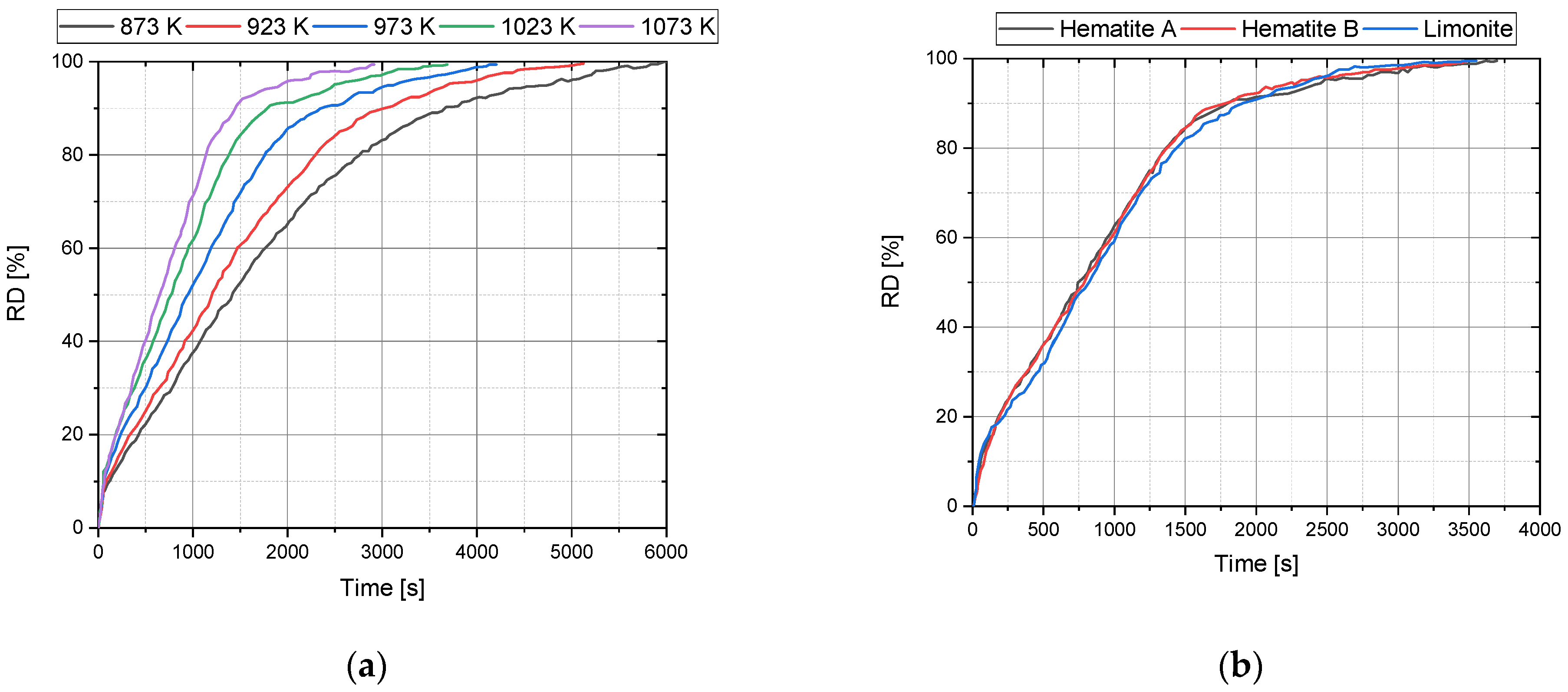

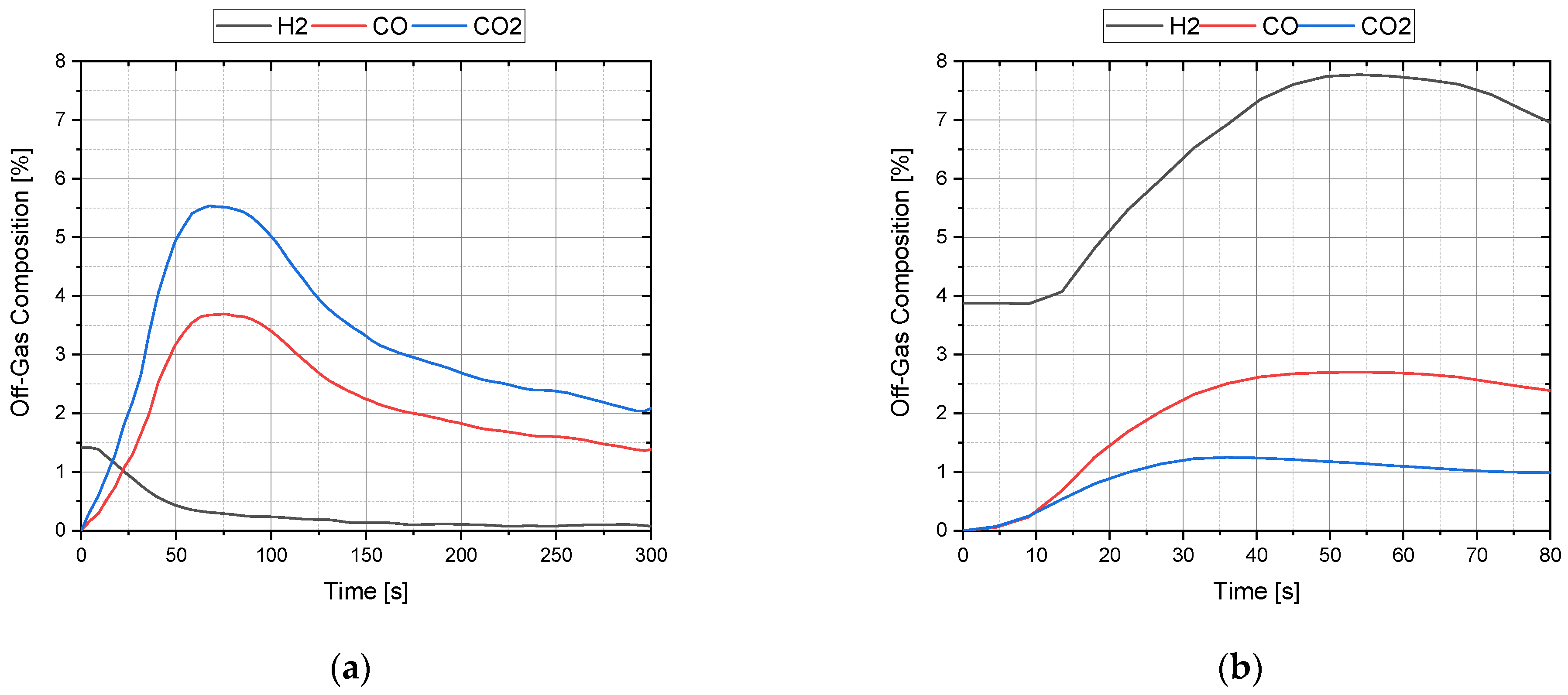
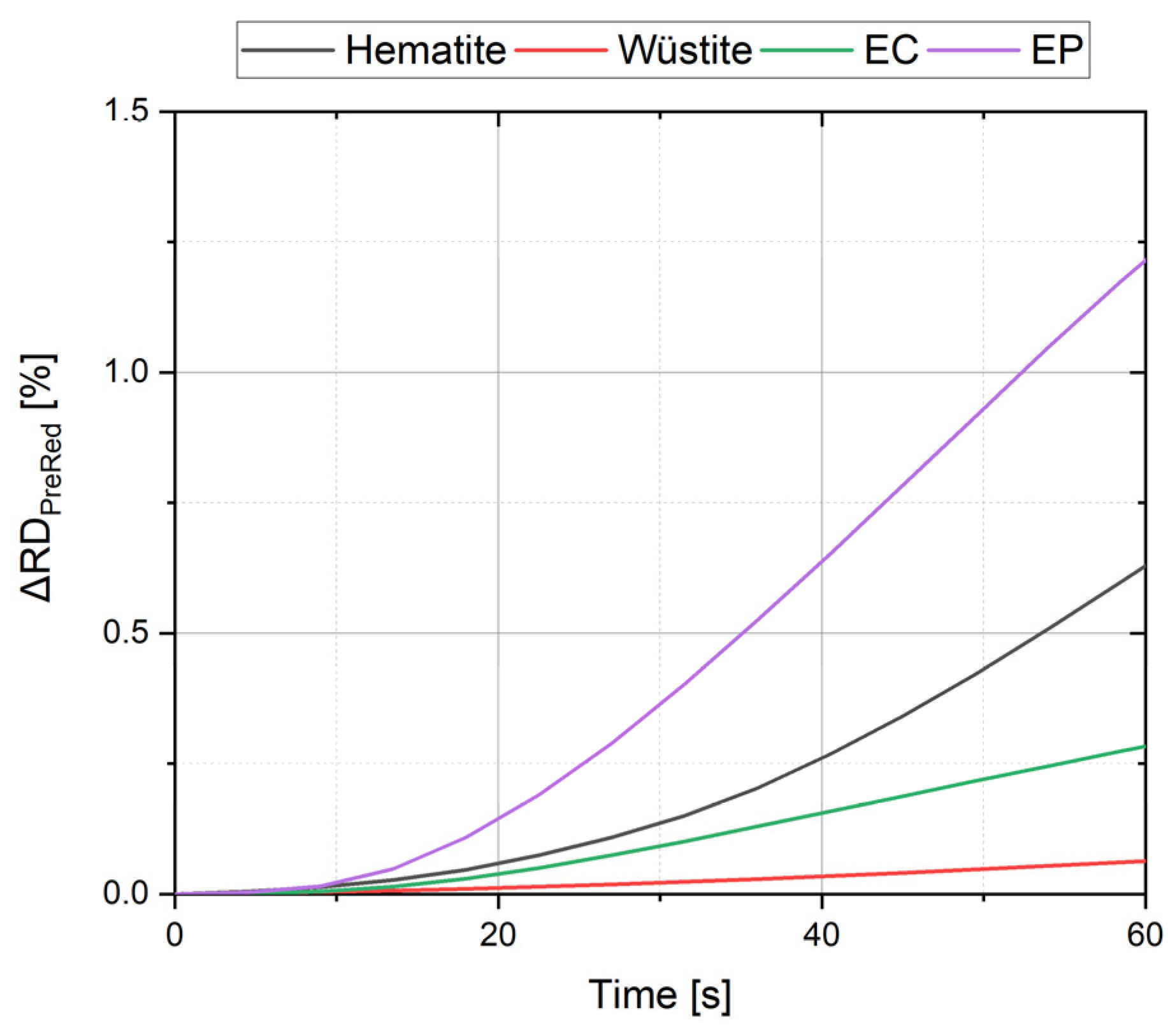
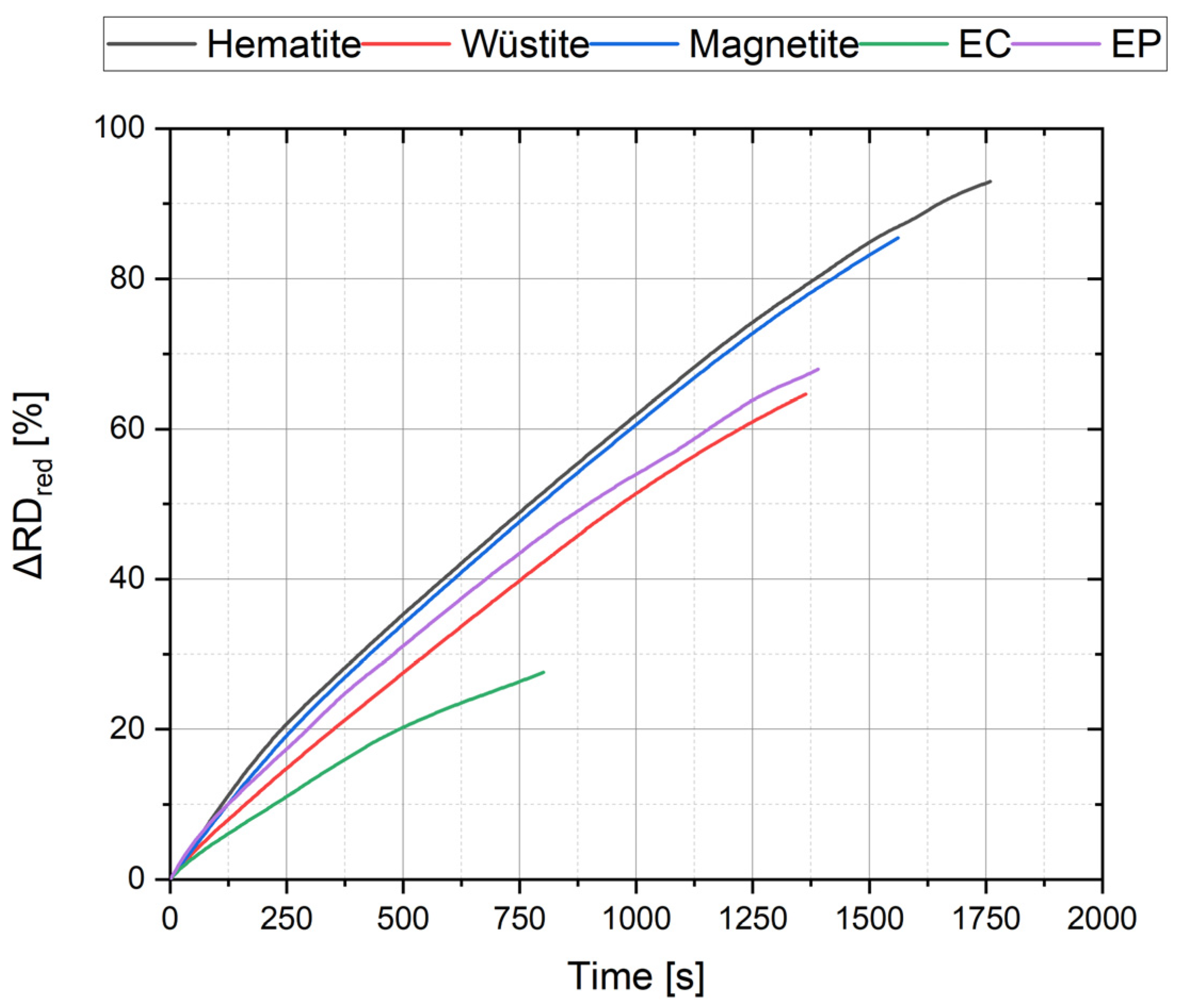


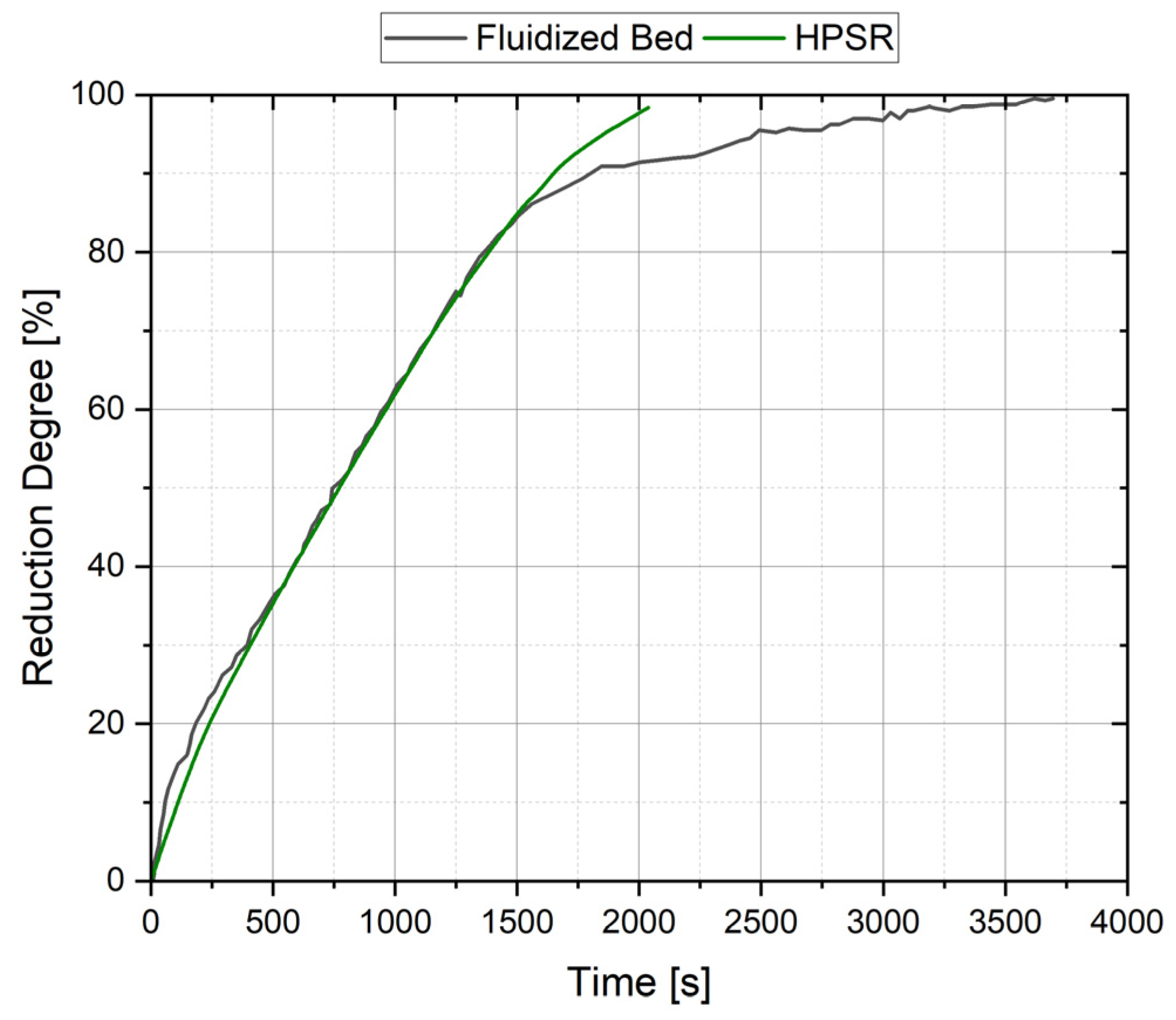
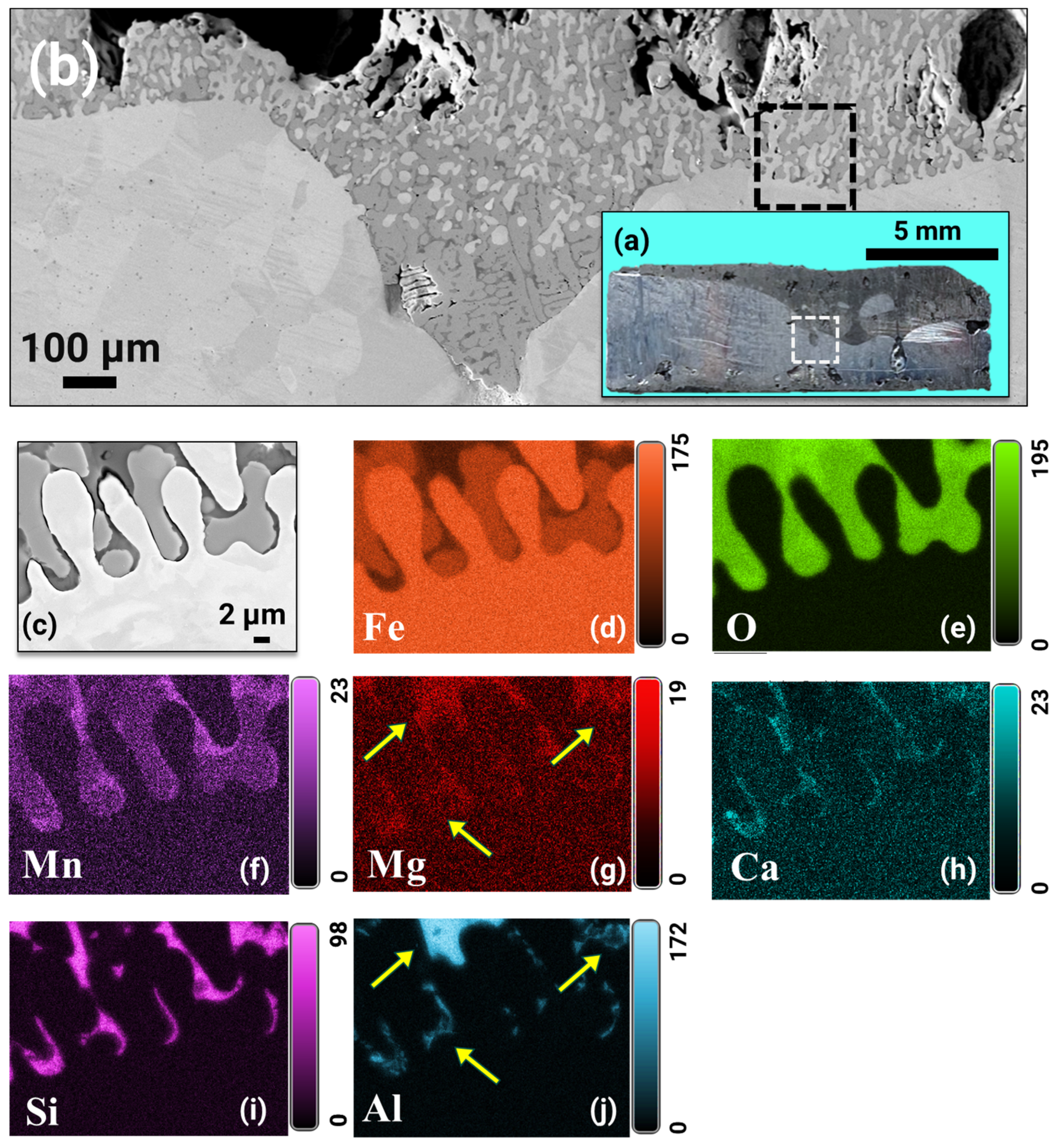
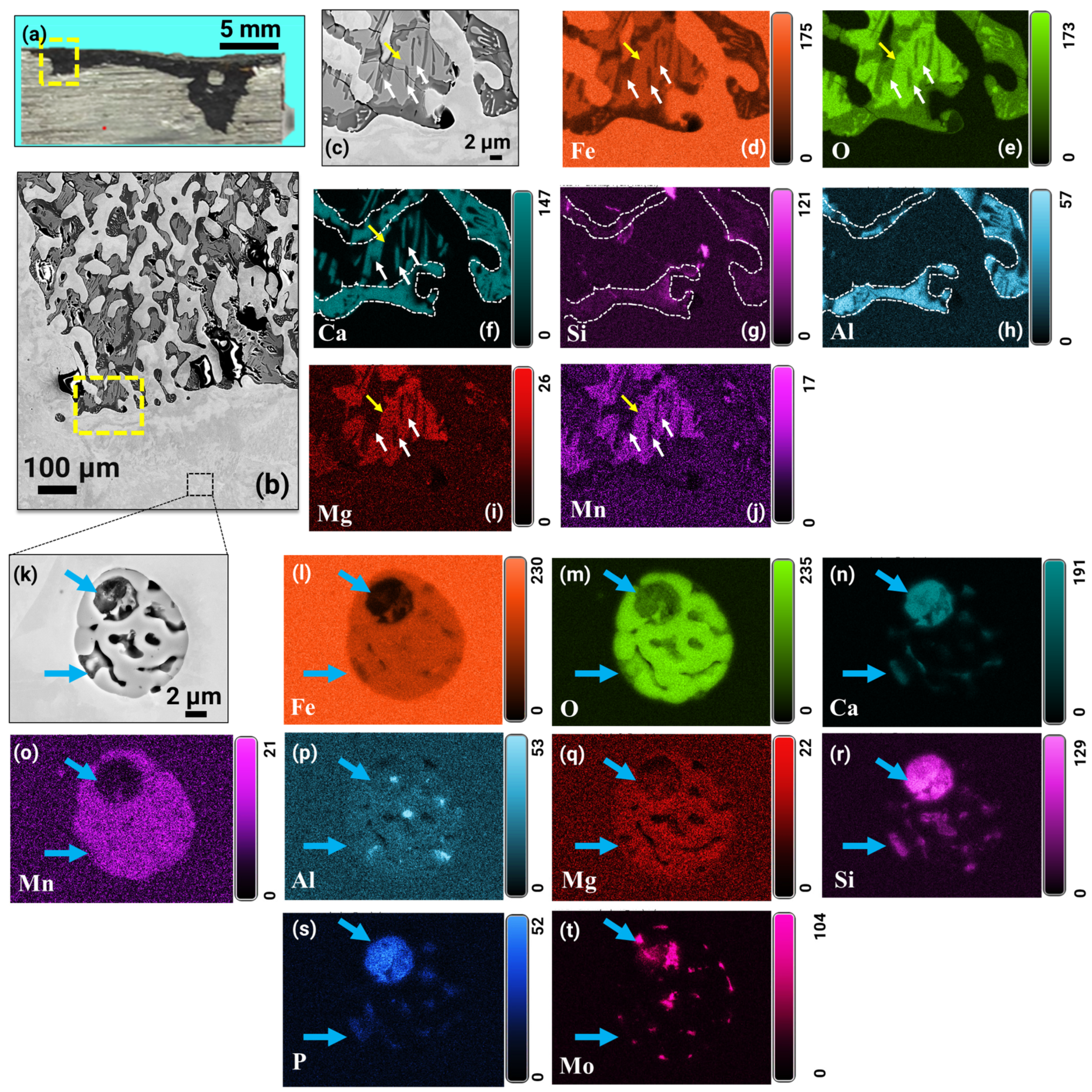
| Element | Hematite 1 (wt.%) | Magnetite 2 (wt.%) | Wüstite (wt.%) | EC (wt.%) | EP (wt.%) |
|---|---|---|---|---|---|
| Fetot | 65.81 | 69.76 | 69.16 | 73.70 | 62.10 |
| Femet | - | - | - | 45.50 | 11.80 |
| Fe2O3 | 92,83 | 66.29 | 0.04 | 11.54 | 47.02 |
| FeO | 1.07 | 30.03 | 88.96 | 25.90 | 22.40 |
| SiO2 | 1.69 | 2.32 | 6.54 | 1.69 | 1.25 |
| Al2O3 | 1.01 | 0.04 | 1.96 | 0.50 | 0.20 |
| CaO | - | 0.15 | 1.09 | 9.11 | 6.68 |
| ZnO | - | - | - | 0.89 | 3.39 |
| Product Name | Purity [%] | O2 [ppm] | H2O [ppm] | N2 [ppm] |
|---|---|---|---|---|
| Hydrogen 5.0 | ≥99.999 | ≤2 | ≤5 | ≤3 |
| Argon 5.0 | ≥99.999 | ≤2 | ≤3 | ≤5 |
| Experiment Number | Input Material [-] | Iron Ore Type [-] | Batch-Wise Charged Mass [g] | Electrode Gap [mm] | Hydrogen Content during Reduction [%] | RDOre [%] |
|---|---|---|---|---|---|---|
| Ex. 1 | Hematite | Hematite | 100 | 20–30 | 40 | 3.2 |
| Ex. 2 | Magnetite | Magnetite | 100 | 20–30 | 40 | 13.8 |
| Ex. 5 | EP | Residual | 99.6 | 20–30 | 40 | 30.4 |
| Ex. 3 | Wustite | Wüstite | 99.3 | 20–30 | 40 | 35.1 |
| Ex. 4 | EC | Residual | 100.3 | 20–30 | 40 | 71.7 |
| Iron Ore Type [-] | Batch-Wise Charged Mass [g] | Oxygen via FeO [g] | Oxygen via Fe2O3 [g] | Total Oxygen [g] | Reduction Time [s] | Average Oxygen Removal Rate [gOxygen/min] |
|---|---|---|---|---|---|---|
| Hematite 1 | 100 | 0.231 | 27.072 | 27.3 | 1764 | 0.93 |
| Magnetite 2 | 99.3 | 6.428 | 19.155 | 25.58 | 1566.0 | 0.98 |
| Wüstite | 100 | 19.217 | 0.012 | 19.23 | 1363.5 | 0.85 |
| Residual EC | 100.3 | 5.6 | 3.368 | 8.97 | 805.5 | 0.67 |
| Residual EP | 99.6 | 4.809 | 13.628 | 18.44 | 1395 | 0.79 |
| Parameter | HPSR | Fluidized Bed [19] |
|---|---|---|
| Iron ore type | Hematite | Hematite |
| Fe tot [%] | 65.81 | 63.60 |
| Grain size [µm] | 25–125 | 250–500 |
| Sample mass [g] | 100 | 400 |
| Temperature [K] | 1973–3298 | 1023 |
| H2-content [%] | 40 | 65 |
| Total flow rate [Nl/min] | 5 | 25.9 |
| Specific H2 input [Nl H2/kg Ore] | 20 | 42.1 |
Disclaimer/Publisher’s Note: The statements, opinions and data contained in all publications are solely those of the individual author(s) and contributor(s) and not of MDPI and/or the editor(s). MDPI and/or the editor(s) disclaim responsibility for any injury to people or property resulting from any ideas, methods, instructions or products referred to in the content. |
© 2023 by the authors. Licensee MDPI, Basel, Switzerland. This article is an open access article distributed under the terms and conditions of the Creative Commons Attribution (CC BY) license (https://creativecommons.org/licenses/by/4.0/).
Share and Cite
Ernst, D.; Manzoor, U.; Souza Filho, I.R.; Zarl, M.A.; Schenk, J. Impact of Iron Ore Pre-Reduction Degree on the Hydrogen Plasma Smelting Reduction Process. Metals 2023, 13, 558. https://doi.org/10.3390/met13030558
Ernst D, Manzoor U, Souza Filho IR, Zarl MA, Schenk J. Impact of Iron Ore Pre-Reduction Degree on the Hydrogen Plasma Smelting Reduction Process. Metals. 2023; 13(3):558. https://doi.org/10.3390/met13030558
Chicago/Turabian StyleErnst, Daniel, Ubaid Manzoor, Isnaldi Rodrigues Souza Filho, Michael Andreas Zarl, and Johannes Schenk. 2023. "Impact of Iron Ore Pre-Reduction Degree on the Hydrogen Plasma Smelting Reduction Process" Metals 13, no. 3: 558. https://doi.org/10.3390/met13030558
APA StyleErnst, D., Manzoor, U., Souza Filho, I. R., Zarl, M. A., & Schenk, J. (2023). Impact of Iron Ore Pre-Reduction Degree on the Hydrogen Plasma Smelting Reduction Process. Metals, 13(3), 558. https://doi.org/10.3390/met13030558







